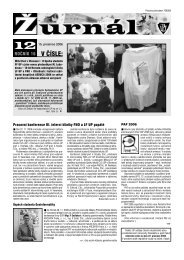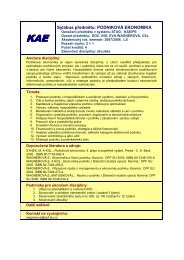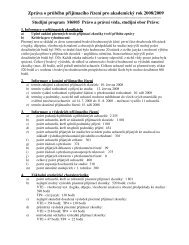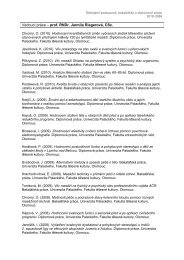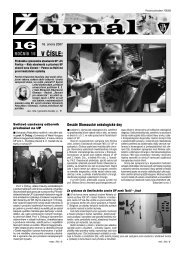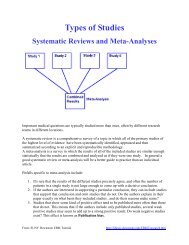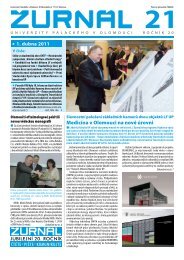38 Acta Univ. Palacki. Olomuc., Gymn. 2004, vol. 34, no. 2rhizoid joints, of the trunk musculature and the limbs.For training schedules aimed at children and youth, itis strongly recommended to include additional sportsactivities, gymnastic exercises and stretching exercisesfor greater articulation.Both the body height and weight of climbers werewithin the limits of standard variations for the averagepopulation in the Czech Republic (body height –– 179.3 cm, n.i. = 0.20 s, body weight 73.3 kg, n.i. == –0.26 s). For comparison with the population standard,we always calculated the weighted average andweighted standard deviations for the relevant age category.During examination of the postural muscles, wefound a comparatively low frequency of shortened muscleseven in the age group of Adultus and Maturus.The most problematic of the muscular region is thebilateral m. trapezius where the shortening occurredin 33.3% and 22.2%. We assume that the conditionsand functionality of m. trapezius are considerably influenced by the technique of climbing and belay, andit also reflects the emotional state of the individual. In22% a shortening of the spinal erector in the lumbararea occurred.The incidence of muscular shortening was in directrelation to the performance of climbers who have beendoing this sport from 1 to 9 years on the levels of difficultybetween Vth and IXth (the shorter the climbingtime, the greater the extent of muscle shortening for anindividual).With regard to muscles with a predominantly phasicfunction, a certain debilitation was detected in 19.45% atthe m. serratus anterior and mm. rhomboidei (19.45%).Even in this case we assume that this finding is relatedto the condition of m. trapezius, further of m. latissimusdorsi and is probably conditioned by the length of trainingand climbing technique.Substitute motor stereotypes were not found, whichis surprising with regard to the thus far known highfrequencies in childhood, adolescence and in the adultpopulation. Therefore we consider the infl uence ofthe mechanism of the evocation of evolutionarily old,early coded models of reflexive motorics. The evolutionprocess of the change of functional involvement of m.gluteus maximus from an abductor muscle to a musclefor extension in the hip joint is connected with habitualbipeds and with morphological adaptation to it.According to Vojta et al. (1995), reflexive creepingand refl exive turning are congenital global models ofmotor ontogenesis. During ontogenesis of erection, theybecame polymorphic, and development ensued.Free climbing is thus a natural implementation ofthese basic models in space. The genetically coded locomotormodel is, during the learning (training) process,specialized IAW its utilization in sports.During climbing, the muscle groups of the upperpart of the body are most involved, especially the antebrachii.The body of a climber, due to the elevatorof the rhizoid joint, moves and thus a high afference isspontaneously activated. During climbing, it is necessaryto involve a large range of joint motility to limitlevels. A major, actively performed flexion stage of thehip joint is related not only to the fl exion but also tothe external rotation and abduction of the thigh. Alsothe adductors go into contraction and, together withthe external rotation and femoral abduction, into extension(zero or very low incidence of contraction of thesemuscles – Fig. 1). Due to contraction of the abdominalFig. 1The frequency of shortening of postural muscles and muscular groups of climbers (n = 36, 1 = 2.78%) and judoists(n = 30, 1 = 3.33%)10090807060% 5040302010012345678muscle, muscular group9climbersjudoistsjudoists1011climbers1 m. triceps surae dex.2 knee joint flexors dex.3 m. rectus femoris dex.4 m. tensor fasciae latae dex.5 hip joint adductors dex.6 m. iliopsoas dex.7 m. quadratus lumborum dex.8 m. erector spinae9 m. pectoralis major dex.10 m. trapezius sin.11 m. trapezius dex.
Acta Univ. Palacki. Olomuc., Gymn. 2004, vol. 34, no. 2 39wall, dorsal pelvic fl exion is evoked involving the backmuscles and the ischiocrural muscles. The bias positionof the pelvis on a frontal level is exerted by m. latissimusdorsi and m. quadratus lumborum. The condition of thesemuscles ranged from very good to excellent.Three of the tested climbers belonging to the MaturusI (35–38 years) age group have been actively climbingfor 17–22 years, with the achieved performance levelsof between IX–X+. Shortening of the postural musclesoccurred twice at m. trapezius only, muscle shorteningonly once at m. serratus anterior and mm. rhomboidei.Substitute motor stereotypes were not found again.In fact, the group of climbers did not complain ofsubjective pains in individual joint areas, apart fromhand joints in 27.78% and knee joints in 16.67%. Painin the cervical region of the spine was felt by 11.11% ofthe tested.Judoists belonging to the Juvenis (15–17 years) agegroup were below average in both their body height andweight (height 170.23 cm, n.i. = –0.80, weight 58.35 kg,n.i. = –0.86). In adult men (18–23 years) these basicantropometric parameters were within limits of standardvariations (weight 180.0 cm, n.i. = 0.21, weight70.81 kg, n.i. = –0.29), older men (24–29 years) weretaller and had above average weight (height 181.25 cm,n.i. = 0.55, weight 89.88 kg, n.i. = 1.24). For judo itis a remarkable advantage to be in the higher weightcategory because for an individual with these dispositions,it is easier to defend against an opponent whoattempts to destabilize his center of gravity.For an assessment of the overall condition of musclefunctions, we merged the age categories Juvenisand Adultus into one group.The resulting situation was signifi cantly worsethan in the case of climbers (Fig. 1). The highest frequencyof shortening (60% and exceeding 60%) wasshown by the knee flexors and decreasing bundles ofm. trapezius. Muscle groups securing motions in thehip joint were almost at half strength of the group inthe process of shortening, which makes evident thefrequent abidance in flexion positions and insufficientcompensation in the training process. An incorrectattitude to compensation exercises is generally known.These exercises are often considered by trainers andathletes to be a waste of time. Without any statisticalimportance of differences, there were only frequencyfi ndings of shortening at the m.erector spinae andm.pectoralis major dex.The established conditions of shortening correspondto the high percentage of substitution motorstereotypes in the area of hip joint, in the sense of primaryactivation of the hamstrings during extension.This knowledge can further expand the scope ofexercises in health-oriented physical education.Fig. 2Frequency of muscle weakness and substitutional motor stereotypes for the group of judoists (n = 30, 1 = 3.33%)10090807060% 5040302010012muscle, muscular group3456climbersjudoistsjudoistsclimbers1 nape flexion2 trunk flexion3 lower limb extension4 lower limbs abduction5 push-up test6 higher limb abduction
- Page 1 and 2: ACTAUNIVERSITATIS PALACKIANAE OLOMU
- Page 3 and 4: ACTAUNIVERSITATIS PALACKIANAE OLOMU
- Page 5: Acta Univ. Palacki. Olomuc., Gymn.
- Page 8 and 9: 8 Acta Univ. Palacki. Olomuc., Gymn
- Page 10 and 11: 10 Acta Univ. Palacki. Olomuc., Gym
- Page 12 and 13: 12 Acta Univ. Palacki. Olomuc., Gym
- Page 14: 14 Acta Univ. Palacki. Olomuc., Gym
- Page 17: Acta Univ. Palacki. Olomuc., Gymn.
- Page 20 and 21: 20 Acta Univ. Palacki. Olomuc., Gym
- Page 22: 22 Acta Univ. Palacki. Olomuc., Gym
- Page 26 and 27: 26 Acta Univ. Palacki. Olomuc., Gym
- Page 28 and 29: 28 Acta Univ. Palacki. Olomuc., Gym
- Page 32 and 33: 32 Acta Univ. Palacki. Olomuc., Gym
- Page 34 and 35: 34 Acta Univ. Palacki. Olomuc., Gym
- Page 36 and 37: 36 Acta Univ. Palacki. Olomuc., Gym
- Page 40 and 41: 40 Acta Univ. Palacki. Olomuc., Gym
- Page 43 and 44: Acta Univ. Palacki. Olomuc., Gymn.
- Page 45 and 46: Acta Univ. Palacki. Olomuc., Gymn.
- Page 47 and 48: Acta Univ. Palacki. Olomuc., Gymn.
- Page 49 and 50: Acta Univ. Palacki. Olomuc., Gymn.
- Page 51 and 52: Acta Univ. Palacki. Olomuc., Gymn.
- Page 53 and 54: Acta Univ. Palacki. Olomuc., Gymn.
- Page 55 and 56: Acta Univ. Palacki. Olomuc., Gymn.
- Page 57 and 58: Acta Univ. Palacki. Olomuc., Gymn.
- Page 59: Acta Univ. Palacki. Olomuc., Gymn.
- Page 62 and 63: 62 Acta Univ. Palacki. Olomuc., Gym
- Page 64 and 65: 64 Acta Univ. Palacki. Olomuc., Gym
- Page 66 and 67: 66 Acta Univ. Palacki. Olomuc., Gym
- Page 68 and 69: 68 Acta Univ. Palacki. Olomuc., Gym
- Page 70 and 71: 70 Acta Univ. Palacki. Olomuc., Gym
- Page 72 and 73: 72 Acta Univ. Palacki. Olomuc., Gym
- Page 74 and 75: 74 Acta Univ. Palacki. Olomuc., Gym
- Page 76 and 77: 76 Acta Univ. Palacki. Olomuc., Gym
- Page 78 and 79: ACTAUNIVERSITATIS PALACKIANAE OLOMU




